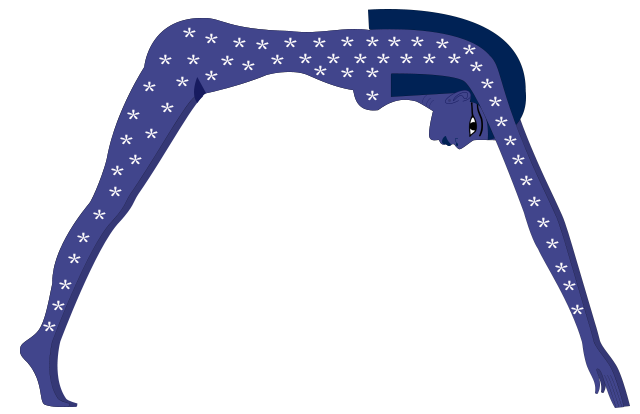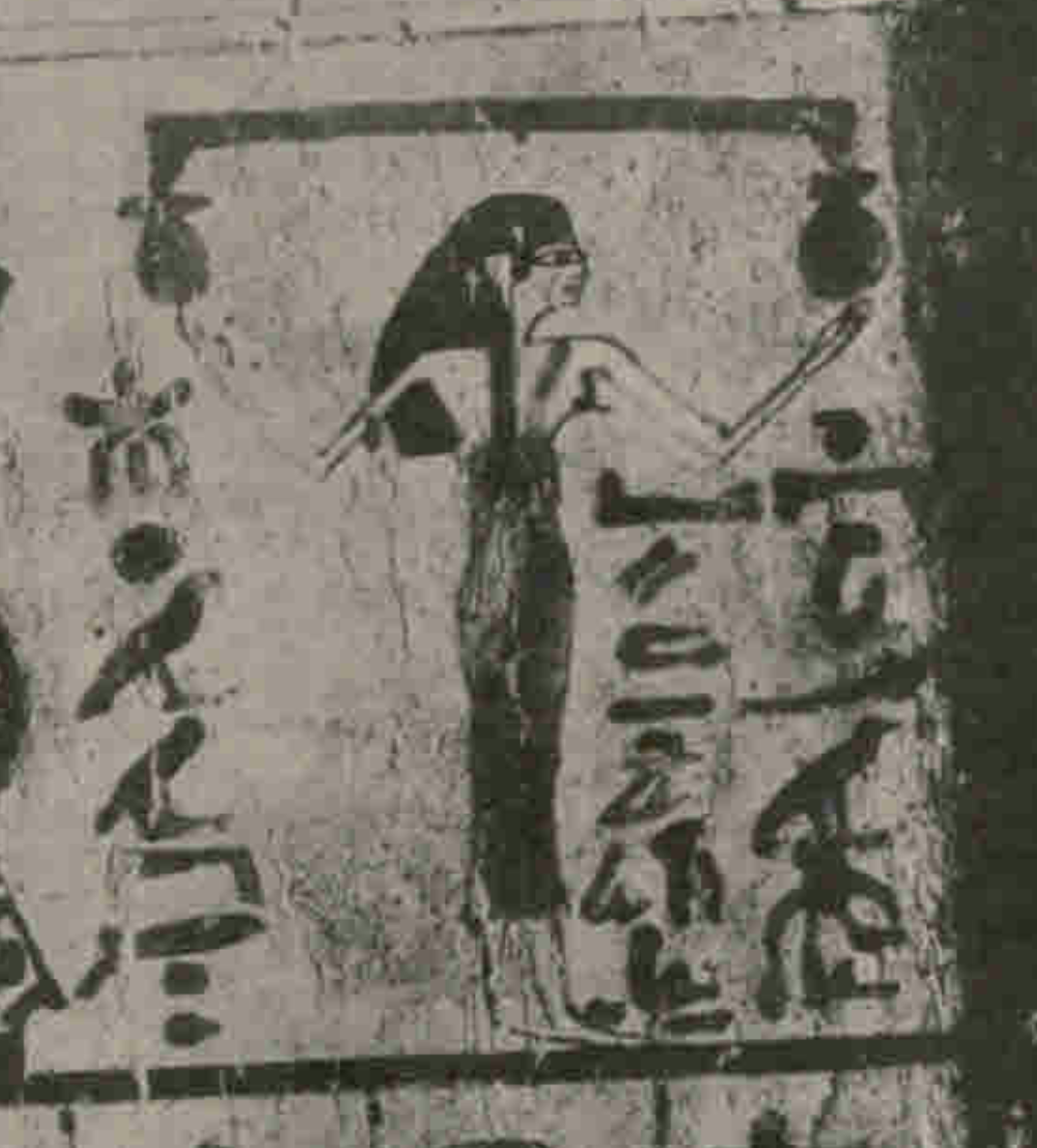Nut
Nut (Ancient Egyptian: Nwt, Coptic: Ⲛⲉ) is the goddess of the sky, stars, cosmos, mothers, astronomy, and the universe in the ancient Egyptian religion. She was seen as a star-covered nude woman arching over the Earth, or as a cow. She was depicted wearing the water-pot sign (nw) that identifies her. Nut is comparable to the Mesopotamian goddess Ninhursag (the "lady of heaven") also sharing her role as mother of the gods.
Name
The pronunciation of ancient Egyptian is uncertain because vowels were long omitted from its writing, although her name often includes the unpronounced determinative hieroglyph for "sky." Her name Nwt, itself also meaning "Sky," is usually transcribed as "Nut" but also sometimes appears in older sources as Nunut, Nent, and Nuit.
She also appears in the hieroglyphic record by a number of epithets, not all of which are understood.
- Coverer of the Sky: Nut was the goddess of the visible sky which is why she's depicted on all fours arching her back upward in a "covering" position that encompasses the semi-sphere of the visible sky as it can be observed from the perspective of the earth. During night time her body was believed to be covered in stars which were projected on her since she encompassed the earth covering it from the open sky, and as such the stars would touch her instead and become visible on her body.
- She Who Protects: Among her jobs was to envelop and protect Ra, the sun god.
- Mistress of All or "She who Bore the Gods": Originally, Nut was said to be lying on top of Geb (Earth) and continually having intercourse. During this time she birthed her children.
- She Who Holds a Thousand Souls: Because of her role in the rebirthing of Ra every morning and in her son Osiris' resurrection, Nut became a key goddess in many of the myths about the afterlife.
Role
Nut was the goddess of the sky and all heavenly bodies, a symbol of protecting the dead when they enter the afterlife. According to the Egyptians, during the day, the Egyptian decans would make their way across her body. Then, at dusk, they would be swallowed, pass through her belly during the night, and be reborn at dawn. She was often painted on the inside lid of the sarcophagus, protecting the deceased. The vaults of tombs were often painted dark blue with many stars as a representation of Nut.
Nut is a daughter of Shu and Tefnut. Her brother and husband is Geb. She had four children – Osiris, Set, Isis, and Nephthys – to which is added Horus in a Graeco-Egyptian version of the myth of Nut and Geb. She is considered one of the oldest deities among the Egyptian pantheon, with her origin being found on the creation story of Heliopolis. She was originally the goddess of the nighttime sky, but eventually became referred to as simply the sky goddess. Her headdress was the hieroglyph of part of her name, a pot, which may also symbolize the uterus. Mostly depicted in nude human form, Nut was also sometimes depicted in the form of a cow whose great body formed the sky and heavens, a sycamore tree, or as a giant sow, suckling many piglets (representing the stars).
A sacred symbol of Nut was the ladder used by Osiris to enter her heavenly skies. This ladder-symbol was called maqet and was placed in tombs to protect the deceased, and to invoke the aid of the deity of the dead. Nut and her brother, Geb, may be considered enigmas in the world of mythology. In direct contrast to most other mythologies which usually develop a sky father associated with an Earth mother (or Mother Nature), she personified the sky and he the Earth.
Nut is also the barrier separating the forces of chaos from the ordered cosmos in the world. She was pictured as a woman arched on her toes and fingertips over the Earth; her body portrayed as a star-filled sky. Nut's fingers and toes were believed to touch the four cardinal points or directions of north, south, east, and west.
Because of her role in saving Osiris, Nut was seen as a friend and protector of the dead, who appealed to her as a child appeals to its mother: "O my Mother Nut, stretch Yourself over me, that I may be placed among the imperishable stars which are in You, and that I may not die." Nut was thought to draw the dead into her star-filled sky, and refresh them with food and wine: "I am Nut, and I have come so that I may enfold and protect you from all things evil."
Nut and Ra
Ra, the sun god, was the second to rule the world, according to the reign of the gods. He decreed, "Nut shall not give birth any day of the year." At that time, the year was only 360 days. Nut spoke to Thoth, god of wisdom, and he had a plan. Thoth gambled with Khonsu, god of the Moon, whose light rivaled that of Ra's. Every time Khonsu lost, he had to give Nut a piece of his moonlight. Khonsu lost so many times that Nut had enough moonlight to make five extra days. Since these days were not part of the existing Egyptian calendar, Nut could have her children.
She had five children on each of the five days:
- Osiris, later ruler of the gods and then god of the dead.
- Horus the Elder, god of war.
- Set, god of evil and the desert.
- Isis, goddess of magic.
- Nephthys, goddess of water.
When Ra found out, he was furious. He separated Nut from her husband Geb for eternity. Her father, Shu, was given the job to keep them apart. Nevertheless, Nut did not regret her decision.
The Book of Nut
The Book of Nut is a modern title of what was known in ancient times as "The Fundamentals of the Course of the Stars."
This is an important collection of ancient Egyptian astronomical texts, perhaps the earliest of several other such texts, going back at least to 2,000 BC. Nut, being the sky goddess, plays the primary role in the Book of Nut. The text also tells about various other sky and Earth deities, such as the star deities and the decans deities. The cycles of the stars and planets, as well as timekeeping are also covered in the book.
Nuit
Nuit is a goddess in Thelema and serves as the speaker in the first Chapter of The Book of the Law, the sacred text written or received in 1904 by Aleister Crowley. This goddess was based on the basic appearance and role of Nut.
Within Crowley's system, she is one-third of the triadic cosmology, along with Hadit (her masculine counterpart), and Ra-Hoor-Khuit, the Crowned and Conquering Child. She has several titles, including "Our Lady of the Stars", and "Lady of the Starry Heaven". In The Book of the Law, she says of herself: "I am Infinite Space, and the Infinite Stars thereof", and in other sections she is called "Queen of Heaven," and "Queen of Space."
Nuit is symbolized by a sphere whose circumference is nowhere and whose center is everywhere, whereas Hadit is the infinitely small point at the center of this sphere. According to Thelemic doctrine, it is the interaction between these two cosmic principles that creates the manifested universe similar to the gnostic syzygy.
See also
- Tezcatlipoca - The Aztec god of the night sky.


